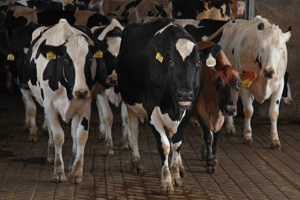MAY 2016
Jeffrey B. Bender DVM
Director/CAHFS, Veterinary Population Medicine, University of Minnesota College of Veterinary Medicine

Moving and handling 1400-pound animals is not a job for everyone – it is however, one that dairy farmers do every day. Across the Midwest large dairy cattle are moved to and from the parlor several times each day. Also, when sows weighing 300 to 400 pounds are placed in group pens, human caretakers are potentially at risk for injuries. Unfortunately, livestock-related injuries account for a high rate of lost work days.
People are a major source of anxiety for the cow or the pig. Stressed cattle and pigs are more difficult to handle and this puts workers at an increased risk of accidents. Much of an animal’s anxiety comes from how they are handled. Studies have shown cows handled by an aversive handler had reduced milk efficiency compared to cows with gentle handlers. Animals quickly learn to recognize individuals and can distinguish between those who treat them gently and those who do not.
Low-stress animal handling or stockmanship focuses on the handling interactions (i.e. communication) between humans and cows and includes low-stress handling techniques. Stockmanship takes advantage of the basic, natural movements of livestock and is a method for humans to interact with these animals in a way that they understand. Knowing livestock behavior is the key to good stockmanship. For example, a calm and relaxed cow at milking means minimal defecation and kicking in the milking parlor, and improved milk let-down. Farmers using low stress animal handling methods are less likely to be injured and face fewer challenges moving cattle.
DAIRY STOCKMANSHIP RESOURCES
To help farmers, the UMASH group has developed a series of videos and fact sheets in English and Spanish for working with dairy cattle. We welcome your comments and suggestions on these resources and encourage you to share them with other colleagues who may benefit. In addition to the downloadable format on our website, we have the materials available on DVD which includes additional UMASH safety resources. DVD’s can be mailed to the worksite by providing name and mailing address. Please let us know what you think and how you use these resource in the workplace. Comments can be sent to ctrefry@umn.edu.
